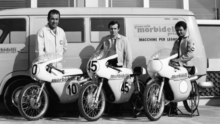Apr. 21, 2008 – Industry Leaders Q&A with Dan Patterson of Lehman Trikes Inc.
Some three years ago, Dan Patterson thought he was headed for retirement. Instead officials at Lehman Trikes Inc. convinced him to help guide the longtime trike manufacturer to new levels of growth. The plan obviously worked for both parties: Lehman has seen constant sales growth, including a retail revenue increase of 37 percent in its last fiscal year. Plus, Patterson is already thinking ahead after spending the past few years transferring the bulk of the company’s operations to the United States and then building the necessary staffing and infrastructure. “I can tell you right now,” he said, “we already need to start looking for additional expansion.”
What’s the biggest challenge for the industry and what should be done about it?
I would answer that in two ways. One, I believe the industry as a whole is going to go through some challenging times this year, next year and maybe even further out because of the state of the union and the effect on motorcycles. It’s going to be an interesting time who comes out ahead at the end of this year and going into the following year. For the trike industry, we’ve seen nothing but double digit growth for the last four years and I expect that to sustain itself over the next four-five years. And for us in the trike industry, it’s really keeping us with the rapid growth that is the real challenge for us.
We’ve seen a shift in demographics, both in the type of riders and the gender. And I think the motorcycle industry as a whole has seen that. There are more big bikes being sold today than there ever has been in the past, and we have more young, independent career-minded young ladies coming into the industry buying our product. So for the trikes, the demographics is just a massive bubble out in front of us as the Baby Boomers head over that break point. They have expendable income and they’re at an age where they want more comfort and stability and safety in their riding and they want to continue their riding experience and the trike offers them that perfect opportunity. The ladies coming into the market are looking at two-wheelers, but we’ve seen a large increase. Thirty percent of our buyers today are females and that was not true two years ago. They want to maintain some level of improved safety without having to balance and control the motorcycle as with a two-wheeler. Three-wheeler gives them the opportunity to instantly become riders. The trike is becoming mainstream by the sheer affect of Harley-Davidson announcing its entry into the market. That puts it more mainstream and our association and alliance with Victory just reaffirms that. I think we have three things going for us: demographics will sustain the growth, the ladies coming into the market will sustain that growth and being in the mainstream, it’s OK, it’s cool to ride a trike now where 10 years ago it wasn’t cool. So our challenge as trike manufacturers is to make sure we’re developing innovative products that services the needs of those folks today and on into the future.
With that comes some real challenges for us as an industry. One is expanding our capacity and our ability to produce product to meet the market demand. We’re trying to stay ahead that curve with capitol expenditures and staffing.
The tightening of credit: I think suppliers of those products are going have to be real innovative without jeopardizing their companies because we’ve seen the rates increase on financing and that drives away some segment of consumer. The last few years there has been fairly aggressive financing going on out there for those products. Today, I see tightening up across the board. So I think that’s something that we’ll be facing: How to sell through with tighter credit limitations. That’s critical. I believe also the challenge for our industry is how to survive over these next 12-24 months. I think through both our OEs and up the distribution network for the dealers, I believe there will be a shake out. I believe there will be a shake out for the trike industry. It historically has been sort of a fragmented segment of our market, more of a cottage industry. I believe tomorrow they (trike OEMs) have to become more mainstream. Those that have the capital or the partnerships or the capacity to build will survive. Those that do not and have not made plans for the future, we’ll probably see some of them disappear from our market.
What’s been the biggest challenge in your current position and how have you dealt with it?
I reflect back maybe three and a half years ago. Our company is probably one of the oldest companies that has been in the trike business, some 24 years now. The biggest challenge I had was reinventing our company to not only meet today’s challenges but tomorrow’s opportunities. That started with making a strategic decision to relocate to the United States. Ninety-five percent of our customers were in the United States. The other (Lehman) company was located across the border in Canada. At the same time, we were seeing a shift in the exchange rate from the dollar to the Canadian dollar, which we were selling U.S. and buying Canadian. If you do the math, that was not a good thing. So the good news is we have re-established ourselves in the United States. The next challenge was staffing to achieve the business goals. We started with three employees approximately three years ago and we’re up over 100 in the U.S. The next strategic decision we made was to shut down our manufacturing operations and set out on a path to create a supply chain to supply us with most of the things we use to manufacture. We changed our focus to design development, marketing and distribution of our product along with assembly and paint. But the actual manufacturing of the subcomponents … we had no suppliers three years ago and we’re 100 percent outsourced today. That was a huge undertaking. I would say reinventing the company while maintaining the rapid growth and staffing to achieve those business goals were all critical these past three years for me.
What’s the best advice you can give to others in the industry?
Probably this year more than any other year we’re at a major inflection point so my best advice for everybody out there is stay focused on your core competency and whatever you do, do it better than anybody else. Provide value. Value is not in the price of the product you’re selling but it’s a whole list of values. What do you offer besides the motorcycle or the trike? Do you offer creative financing? Do you offer excellent service? For example, are you flexible with the folks coming in? Do you do pick up and deliveries? I mean do you really go out of your way to help your customer? My dad told me a long time ago, ‘If you don’t take care of your customers, somebody else will.’ Always take care of those customers. And then focus on your processes, your procedures and the quality of your product and services that you offer. It’s an everyday event because you can always improve on it. And listen to the voice of your customer. They’ll tell you what you’re doing right. They’ll also tell you what you’re doing wrong. The last piece of that is to you need to stay on top of your strategic business plan. We put down our major focus and then the sub-elements of the objectives and then the tactical actions we need to take to execute them. So having a business or strategic plan that you update quarterly and see if you’re on track. If not, then you need to make adjustments. Because if you don’t those adjustments, then you’ll be too far down the stream to take any corrective actions if you need. Build your plan, evaluate, reassess and be agile enough to adjust.








